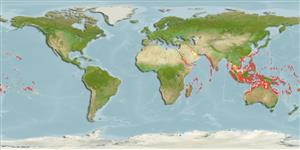Common names from other countries
>
Anguilliformes (Eels and morays) >
Muraenidae (Moray eels) > Muraeninae
Etymology: Gymnothorax: Greek, gymnos = naked + Greek, thorax, -akos = breast (Ref. 45335).
More on author: Bleeker.
Environment: milieu / climate zone / depth range / distribution range
Ecologie
marien rifbewoner; diepte 0 - 50 m (Ref. 30573). Tropical; 30°N - 25°S
Indo-Pacific: Red Sea and East Africa (Ref. 33390) to the Marquesas and Oeno Atoll (Pitcairn Group), north to the Ryukyu and Hawaiian islands, south to New Caledonia and the Austral Islands.
Grootte / Gewicht / Leeftijd
Maturity: Lm ? range ? - ? cm
Max length : 300 cm TL mannelijk / geslacht onbekend; (Ref. 9710); max. gepubliceerd gewicht: 30.0 kg (Ref. 30404)
Dorsale stekels (totaal): 0; Anale stekels 0; Wervels: 137 - 143. Juveniles are tan with numerous large black spots. Adults have black specks that grade into leopard-like spots behind the head and a black area surrounding the gill opening.
Found in lagoon and seaward reefs. Commonly seen species along deep drop-offs and slopes in Indonesian waters (Ref. 48635). Benthic (Ref. 58302). Juveniles more secretive and occur on intertidal reef flats (Ref. 37816). It feeds primarily on fishes and occasionally on crustaceans. This is the largest Indo-Pacific moray eel (Ref. 30404), perhaps reaching 3 m in length. Because of its position at the top of the reef's food chain it is often ciguatoxic. Attacks humans when provoked (Ref. 3132). Minimum depth reported taken from Ref. 10713. Solitary in reef holes (Ref 90102).
Levenscyclus en paargedrag
Maturiteit | Voortplanting | Paaien | Eieren | Fecunditeit | Larven
Observations on prespawning behavior include a pair entwined around one another lying on the bottom of the reef area (Ref. 93344).
Chen, H.-M., K.-T. Shao and C.T. Chen, 1994. A review of the muraenid eels (Family Muraenidae) from Taiwan with descriptions of twelve new records. Zool. Stud. 33(1):44-64. (Ref. 6934)
Status op de Rode Lijst van het IUCN (Ref. 130435)
CITES (Ref. 128078)
Not Evaluated
Gevaar voor de mens
Reports of ciguatera poisoning (Ref. 4690)
Gebruik door de mens
Visserij: visserij voor eigen gebruik; Aquarium: Publieke aquaria
Meer informatie
ReferentiesAquacultuurAquacultuurprofielKweeklijnenGeneticaElectrophoresesErfelijkheidZiektesVerwerkingMassaconversie
Tools
Speciale rapporten
Download XML
Internetbronnen
Estimates based on models
Preferred temperature (Ref.
115969): 25.5 - 29, mean 28.1 (based on 902 cells).
Fylogenetische diversiteitsindex (Ref.
82804): PD
50 = 0.5000 [Uniqueness, from 0.5 = low to 2.0 = high].
Bayesian length-weight: a=0.00052 (0.00033 - 0.00084), b=3.27 (3.14 - 3.40), in cm Total Length, based on LWR estimates for this species & Genus-body shape (Ref.
93245).
Trofisch niveau (Ref.
69278): 3.9 ±0.64 se; based on food items.
Weerstandsvermogen (Ref.
120179): Hoog, minimale populatieverdubbelingstijd minder dan 15 maanden (Fec = 200,000-300,000).
Fishing Vulnerability (Ref.
59153): Very high vulnerability (90 of 100).
